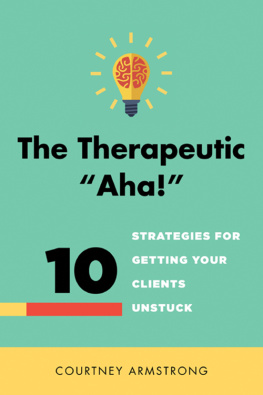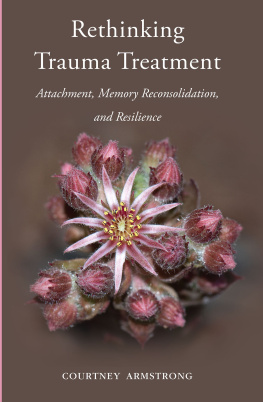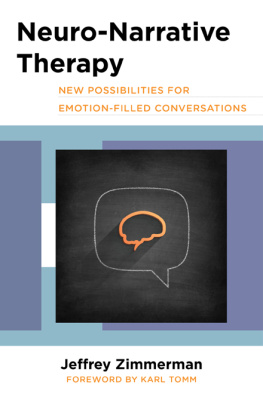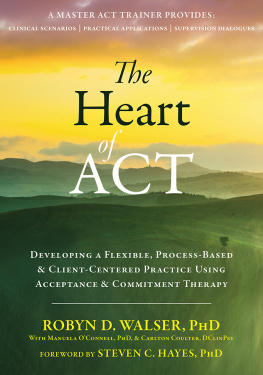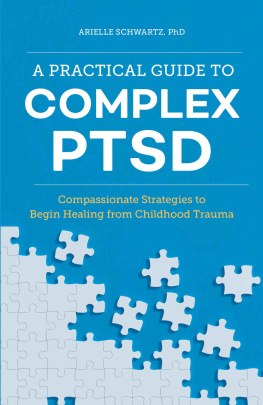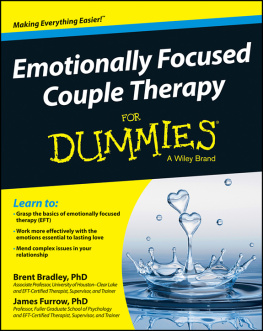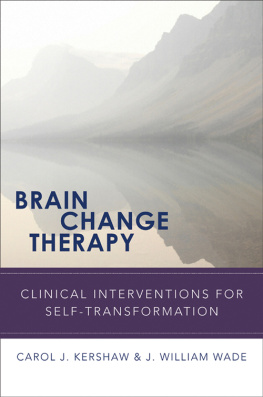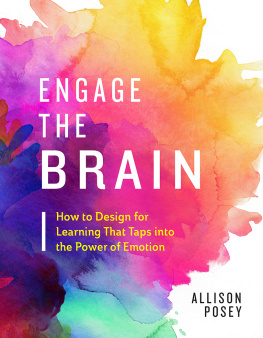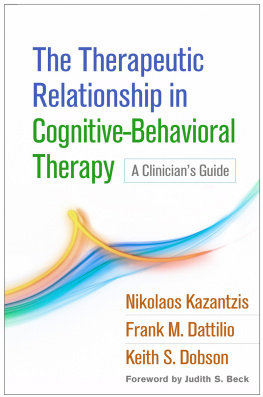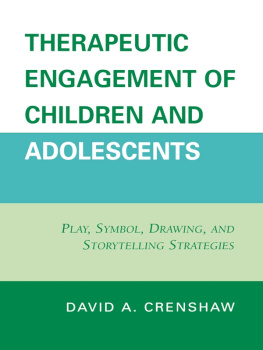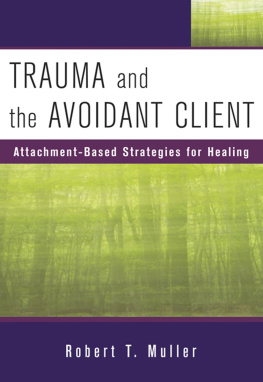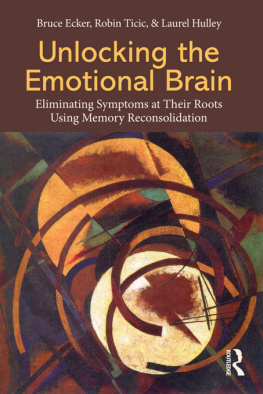
Copyright 2015 by Courtney Armstrong
All rights reserved
First Edition
For information about permission to reproduce selections from this book,
write to Permissions, W. W. Norton & Company, Inc.,
500 Fifth Avenue, New York, NY 10110
For information about special discounts for bulk purchases, please contact
W. W. Norton Special Sales at specialsales@wwnorton.com or 800-233-4830
Production manager: Christine Critelli
Library of Congress Cataloging-in-Publication Data
Armstrong, Courtney.
The therapeutic "aha!" : 10 strategies for getting your clientsunstuck /
Courtney Armstrong.
pages cm. (A Norton professional book)
Includes bibliographical references and index.
ISBN 978-0-393-70840-0 (hardcover)
1. Psychotherapy. I. Title.
RC480.A76 2015
616.89'14dc23
2014038676
W. W. Norton & Company, Inc.
500 Fifth Avenue, New York, N.Y. 10110
www.wwnorton.com
W. W. Norton & Company Ltd.
Castle House, 75/76 Wells Street, London W1T 3QT
To Joel and Buzz
who loved and tamed my emotional brain.
Introduction:
The Power of Emotion
Watching a client transform from a state of angst to enlightenment is exhilarating for a psychotherapist. Even more thrilling is the rare Aha! moment, when a certain realization clicks into place, releases the client from the shackles of an imprisoning belief, and liberates the client toward change. We have all had those eureka experiences in our sessions, but why do they seem so elusive? Do people really make lasting change after they have had such epiphanies? More important, what can you do when the therapy process seems stuck and absolutely no flashes of insight are coming? Is there a certain set of conditions that seem to facilitate therapeutic breakthroughs in sessions? I believe that there is. It all starts with understanding the power of emotion and how to use it in a way that promotes positive shifts in both mind and brain.
Since the dawn of time, humans have attempted to tame passion with reason, usually with limited success. Plato (trans. 2005) compared balancing emotion and reason to a small charioteer attempting to steer two horses running in opposite directions. Centuries later, albeit during the Age of Reason, philosophers such as David Hume concluded, Reason is, and ought only to be the slave of the passions, and can never pretend to any other office than to serve and obey them (1738/2011, p. 174). Even modern neuroscientists acknowledge the futility of attempting to control emotions with rationality, as neuroscientist Joe LeDoux sings with his band, The Amygdaloids (2007): An emotional brain is a hard thing to tame/It just wont stay in its place/Every time I think I got it /It gives me another face.
LeDouxs lyrics in this song refer to the fact that our brains are biologically structured so that when our emotional systems are strongly aroused, they have the capacity to easily override our rational, cognitive systems. We dont need a brain scan to validate this phenomenon. We know it through our experience living as human beings. How many times have you surprised yourself by jumping at the scary part of a movie or shouting something hurtful at someone you love when you feel angry? Although you know the villain in the movie isnt real and the insult to your loved one will only make things worse, your emotional brain ignores this logic and leaps into action. In essence, the emotional brain is our unconscious mind, and scientists estimate that it controls, or at least influences, about 95% of what we do, think, and feel at any given moment.
THE EMOTIONAL BRAIN
Sitting deep in the midbrain between the cortex and brain stem, the emotional brain, or mammalian brain, as pioneering neuroscientist Paul MacLean (1990) called it, is where the majority of neural networks for our attachment schemas, implicit memories, and automatic patterns are stored. Most of the patterns stored in the emotional brain are learned experientially and activated unconsciously.
Contrary to what Freud theorized, the emotional brain is not merely driven by shadowy sexual urges or simplistic self-gratification, nor does it harbor repressed feelings. While it is true that the emotional brain drives our instincts for survival and pleasure, this lower brain isnt as self-serving as weve been led to believe. In fact, as you will learn in , this area of the brain also prompts us to be interested in connecting with others, giving and receiving care, pursuing playful activities, and seeking experiences that inspire us and add to the quality of our lives. After all, life without emotion would be quite dull and seem rather meaningless.
While the emotional brain is generally adaptive and well intentioned, it isnt really fazed by quiet, rational discussion, intellectual insight, or analytical argumentssome of the staples of modern psychotherapy. Instead, the emotional brain learns from experience, association, stimulation of the senses, and repetition. Therefore, no matter how brilliantly our prefrontal cortex delivers intellectual insight and plans elegant coping strategies, the emotional brain is primed to override it all with neural patterns that persist until we intervene with something our emotional brain can understand: a compelling felt experience.
Orchestrating such felt experiences goes beyond simple emotional awareness or emotional catharsis around the problem. Therapists must elicit an affectively engaging experience that changes the emotional meaning of an event. Hitting this neural sweet spot where cognition and emotion synthesize is what I believe creates that Aha moment.
Cognitive-experiential theorist Seymour Epstein (2014) might call this a cognitive-experiential form of therapy because the therapist is still aiding the client in identifying unhelpful thoughts and beliefs but assists the client in changing negative beliefs through the brains subcortical experiential learning systems. Acknowledging the necessity of engaging both rational and experiential systems is especially relevant for intellectual clients who understand their problems all too well but have not been able to change in spite of their insight, like my client Saundra.
SAUNDRAS SUNRISE
Saundra was an attractive, talented surgeon with a Mensa-level IQ who graduated at the top of her class from an Ivy League school. She struggled most of her life with waves of severe depression and anxiety, but in recent years her mood swings had become more frequent and stormy, flooding her personal life and threatening to wreck her career. When she arrived at my office, Saundra clenched her jaw and gripped her wrist as she expressed feeling extremely disappointed with herself. Intellectually, she lamented, I understand what causes the depression and anxiety. Trust me, Ive had years of therapy and tried dozens of medications. I realize my thoughts are irrational and know I developed these patterns because my family of origin was critical, abusive, and chaotic. But Im 40 years old. When am I going to get over it?
As Saundra described her history, I realized she had an excellent grasp of her issues and did not need more knowledge about her situation, nor did she need assistance recognizing cognitive distortions. She saw them staring back at her in bold, living color and put lots of energy into reframing them. Yet her attempts to reason her way out of her feelings only added to her frustration and feelings of inadequacy. It occurred to me that what Saundra was really seeking was a new experience of herself. An experience that would cause her to believe there was more to her than negativity. As we talked, I began to search for experiences or subjects that elicited a smile on her face, passion in her voice, or animated movement in her body. What in Saundras life makes it worth coming to see me? What topics seemed to relax her or energize her?
Next page
